|
Investors were cautious at the beginning of the holiday shortened week as they waited for Fed Chair Janet Yellen's remarks. Pleased with what they heard, stocks rallied. At the end of the week, investors were waiting again, this time for the March U.S. employment report. Ms Yellen maintained the dovish tone of her post meeting press conference while the employment report indicated that the economy as measured by the labor market continues to chug along. And while the unemployment rate ticked up to 5.0 percent from 4.9 percent, it did so for a good reason — many of the discouraged unemployed are looking for jobs again.
March was a good month for the equity indexes as most rebounded from their losses in January and February — but not enough to offset those losses and register a gain for the quarter. The Shanghai Composite and Sensex both recorded double digit gains of 11.7 percent and 10.2 percent respectively in March. On the week however, equities were mostly lower.
Manufacturing PMI — a mixed picture
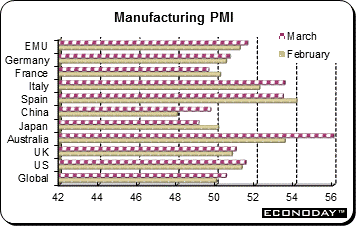 The troubled manufacturing sector performed a little better in March. For the Eurozone as a whole, the PMI reading was 51.6 and 0.4 points higher than its final February reading. However, this was still the second weakest reading in more than a year. The modest improvement reflected slightly stronger growth rates in production and new orders. Employment was up for a 19th successive month but at one of the slowest rates over the period. Inflation developments continued worryingly weak with fresh declines in both input costs and factory gate prices with the drop in the former almost as steep as the six and a half year record seen in February. Regionally Ireland (54.9) was comfortably the best performer ahead of the Netherlands (53.6) and Italy (53.5). Spain (53.4) was not far behind. However, the core countries had a poor month with France (49.6) on the wrong side of 50 and Germany (50.7) only just on the right. The troubled manufacturing sector performed a little better in March. For the Eurozone as a whole, the PMI reading was 51.6 and 0.4 points higher than its final February reading. However, this was still the second weakest reading in more than a year. The modest improvement reflected slightly stronger growth rates in production and new orders. Employment was up for a 19th successive month but at one of the slowest rates over the period. Inflation developments continued worryingly weak with fresh declines in both input costs and factory gate prices with the drop in the former almost as steep as the six and a half year record seen in February. Regionally Ireland (54.9) was comfortably the best performer ahead of the Netherlands (53.6) and Italy (53.5). Spain (53.4) was not far behind. However, the core countries had a poor month with France (49.6) on the wrong side of 50 and Germany (50.7) only just on the right.
Elsewhere, China's manufacturing PMI remained below the breakeven 50 level at 49.7 after sinking to a reading of 48 the month before while Japan dropped into contractionary territory with a reading of 49.1, down from 50.1 in February. However, the PMI improved slightly in the U.S. The index edged up to 51.5 from 51.3 thanks to strength in new orders. The overall global manufacturing PMI climbed from February's stagnant reading of 50 to 50.5.
| |
|
2015 |
2016 |
% Change |
|
Index |
Dec 31 |
Mar 25 |
Apr 1 |
Week |
March |
2016 |
| Asia/Pacific |
|
|
|
|
|
|
|
| Australia |
All Ordinaries |
5344.6 |
5151.6 |
5073.79 |
-1.5% |
4.1% |
-5.1% |
| Japan |
Nikkei 225 |
19033.7 |
17002.8 |
16164.16 |
-4.9% |
4.6% |
-15.1% |
| Hong Kong |
Hang Seng |
21914.4 |
20345.6 |
20498.92 |
0.8% |
8.7% |
-6.5% |
| S. Korea |
Kospi |
1961.3 |
1983.8 |
1973.57 |
-0.5% |
4.1% |
0.6% |
| Singapore |
STI |
2882.7 |
2847.4 |
2818.49 |
-1.0% |
6.5% |
-2.2% |
| China |
Shanghai Composite |
3539.2 |
2979.4 |
3009.53 |
1.0% |
11.8% |
-15.0% |
|
|
|
|
|
|
|
|
| India |
Sensex 30 |
26117.5 |
25337.6 |
25269.64 |
-0.3% |
10.2% |
-3.2% |
| Indonesia |
Jakarta Composite |
4593.0 |
4827.1 |
4843.19 |
0.3% |
1.6% |
5.4% |
| Malaysia |
KLCI |
1692.5 |
1703.8 |
1710.55 |
0.4% |
3.8% |
1.1% |
| Philippines |
PSEi |
6952.1 |
7360.1 |
7245.13 |
-1.6% |
8.9% |
4.2% |
| Taiwan |
Taiex |
8338.1 |
8705.0 |
8657.55 |
-0.5% |
4.0% |
3.8% |
| Thailand |
SET |
1288.0 |
1394.8 |
1400.72 |
0.4% |
5.7% |
8.7% |
|
|
|
|
|
|
|
|
| Europe |
|
|
|
|
|
|
|
| UK |
FTSE 100 |
6242.3 |
6106.5 |
6146.05 |
0.6% |
1.3% |
-1.5% |
| France |
CAC |
4637.1 |
4329.7 |
4322.24 |
-0.2% |
0.7% |
-6.8% |
| Germany |
XETRA DAX |
10743.0 |
9851.4 |
9794.64 |
-0.6% |
5.0% |
-8.8% |
| Italy |
FTSE MIB |
21418.4 |
18165.8 |
17776.84 |
-2.1% |
2.8% |
-17.0% |
| Spain |
IBEX 35 |
9544.2 |
8789.8 |
8602.30 |
-2.1% |
3.1% |
-9.9% |
| Sweden |
OMX Stockholm 30 |
1446.8 |
1345.3 |
1358.22 |
1.0% |
-0.5% |
-6.1% |
| Switzerland |
SMI |
8818.1 |
7775.6 |
7688.34 |
-1.1% |
-0.5% |
-12.8% |
|
|
|
|
|
|
|
|
| North America |
|
|
|
|
|
|
|
| United States |
Dow |
17425.0 |
17515.7 |
17792.75 |
1.6% |
7.1% |
2.1% |
|
NASDAQ |
5007.4 |
4773.5 |
4914.54 |
3.0% |
6.8% |
-1.9% |
|
S&P 500 |
2043.9 |
2035.9 |
2072.78 |
1.8% |
6.6% |
1.4% |
| Canada |
S&P/TSX Comp. |
13010.0 |
13358.1 |
13440.33 |
0.6% |
4.9% |
3.3% |
| Mexico |
Bolsa |
42977.5 |
45647.6 |
46062.920 |
0.9% |
5.0% |
7.2% |
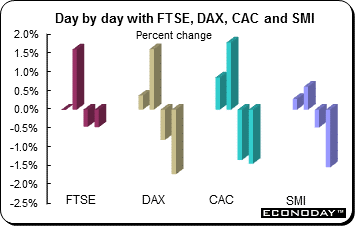 Equities were mostly lower on the week with only the FTSE (up 0.6 percent) and the OMX (up 1.0 percent) gaining. The CAC, DAX and SMI lost 0.2 percent, 0.6 percent and 1.1 percent respectively for the week. However, in March, only the OMX and SMI retreated — both were down 0.5 percent. The FTSE added 1.3 percent in March while the CAC and DAX were up 0.7 percent and 5.0 percent respectively. Equities were mostly lower on the week with only the FTSE (up 0.6 percent) and the OMX (up 1.0 percent) gaining. The CAC, DAX and SMI lost 0.2 percent, 0.6 percent and 1.1 percent respectively for the week. However, in March, only the OMX and SMI retreated — both were down 0.5 percent. The FTSE added 1.3 percent in March while the CAC and DAX were up 0.7 percent and 5.0 percent respectively.
Stocks were pressured Friday due to tumbling Asian markets. Commodity price weakness also weighed at the end of the trading week. But markets here pared their losses after U.S. markets advanced following the release of positive employment and ISM manufacturing reports.
Data in Europe were mixed. March flash harmonized index of consumer prices continued to decline from a year ago. EU Economic confidence — a survey that is closely observed by the ECB — retreated. On the positive side, the Eurozone and UK manufacturing PMIs improved as did French consumer spending. And UK fourth quarter growth was revised upward.
Negative interest rates are not the main policy tool of the European Central Bank for boosting inflation and growth according to ECB Executive Board member Benoit Coeure. Interest rates will not be lowered deeper into "absurdly" negative territory though further moves cannot be ruled out. "But we can never rule out further moves. That would not be credible anyway." Coeure maintained that the ECB still has several tools to boost inflation and support economic growth even after a slew of measures announced earlier this month that included a reduction to all of its main three interest rates and a new long term refinancing operation.
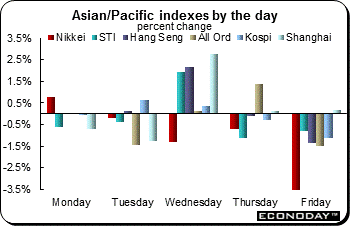 Equities were mixed last week with many indexes pulled down thanks to Friday's losses. The week here ended on a sour note as mixed regional data, sliding oil prices and a Standard & Poor's warning that it could downgrade China's credit rating this year served to increase investor anxiety ahead of the U.S. employment report which was released after markets here were closed for the week. Equities were mixed last week with many indexes pulled down thanks to Friday's losses. The week here ended on a sour note as mixed regional data, sliding oil prices and a Standard & Poor's warning that it could downgrade China's credit rating this year served to increase investor anxiety ahead of the U.S. employment report which was released after markets here were closed for the week.
The Nikkei tumbled 3.5 percent on Friday and in the process erased most of its March monthly gain of 4.6 percent as the yen continued to strengthen and the Bank of Japan's latest Tankan business sentiment survey showed conditions and the outlook among large manufacturers worsened in March. On the week, the Nikkei tumbled 4.9 percent.
Tankan worries
Stocks in Japan suffered their biggest drop in more than a month Friday amid worries about deteriorating sentiment among Japanese companies. In Japan, investors are worried that Prime Minister Shinzo Abe's plan to boost economic growth is losing momentum, as highlighted by the quarterly Tankan which showed a sharp drop in business confidence during the first quarter. A gauge of sentiment among large manufacturers fell to plus 6 in March from plus 12 in December, marking the lowest reading in about three years. The figure represents the percentage of respondents saying business conditions are favorable minus those saying they are unfavorable. Most large manufacturers rely on exports and the rising yen is causing pain for these manufacturers.
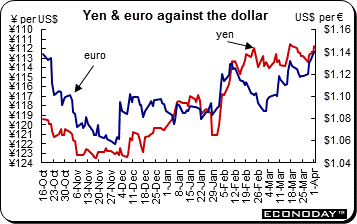 The U.S. dollar retreated against all of its major counterparts including the yen, euro, Swiss franc, pound sterling and the Canadian and Australian dollars. The dollar recorded its worst quarterly performance since 2010 as investors continued to pare their expectations for interest rate increases this year. The dollar tumbled again this week after a speech Tuesday by Federal Reserve Chair Janet Yellen damped investors' expectations for interest rate increases. Ms Yellen said slower growth abroad poses risks to the U.S. economy and justifies a slower path of interest-rate increases. Lower interest rates make the dollar less attractive to yield seeking investors. The speech marked the second time this month that Ms Yellen's dovish comments sent the dollar tumbling. Ms Yellen took a similar tone at the close of the Fed's March 15 and 16 policy meeting, when the Fed reduced the projected path of interest-rate increases this year from four to two. The U.S. dollar retreated against all of its major counterparts including the yen, euro, Swiss franc, pound sterling and the Canadian and Australian dollars. The dollar recorded its worst quarterly performance since 2010 as investors continued to pare their expectations for interest rate increases this year. The dollar tumbled again this week after a speech Tuesday by Federal Reserve Chair Janet Yellen damped investors' expectations for interest rate increases. Ms Yellen said slower growth abroad poses risks to the U.S. economy and justifies a slower path of interest-rate increases. Lower interest rates make the dollar less attractive to yield seeking investors. The speech marked the second time this month that Ms Yellen's dovish comments sent the dollar tumbling. Ms Yellen took a similar tone at the close of the Fed's March 15 and 16 policy meeting, when the Fed reduced the projected path of interest-rate increases this year from four to two.
The sub-zero deposit rates and a super-charged stimulus program from the European Central Bank are not working their usual magic on the euro, which has climbed to a five-month high against the dollar marking a rise of over 5 percent since the day the ECB announced its new stimulus program.
|
|
2015 |
2016 |
% Change |
|
|
Dec 31 |
Mar 25 |
Apr 1 |
Week |
2016 |
| U.S. $ per currency |
|
|
|
|
|
|
| Australia |
A$ |
0.7288 |
0.751 |
0.768 |
2.2% |
5.4% |
| New Zealand |
NZ$ |
0.6833 |
0.669 |
0.690 |
3.2% |
1.0% |
| Canada |
C$ |
0.7231 |
0.754 |
0.769 |
1.9% |
6.3% |
| Eurozone |
euro (€) |
1.0871 |
1.116 |
1.139 |
2.0% |
4.8% |
| UK |
pound sterling (£) |
1.4742 |
1.413 |
1.423 |
0.7% |
-3.5% |
|
|
|
|
|
|
|
| Currency per U.S. $ |
|
|
|
|
|
|
| China |
yuan |
6.4937 |
6.516 |
6.482 |
0.5% |
0.2% |
| Hong Kong |
HK$* |
7.7501 |
7.758 |
7.755 |
0.0% |
-0.1% |
| India |
rupee |
66.1537 |
66.636 |
66.248 |
0.6% |
-0.1% |
| Japan |
yen |
120.2068 |
113.110 |
111.660 |
1.3% |
7.7% |
| Malaysia |
ringgit |
4.2943 |
4.037 |
3.891 |
3.8% |
10.4% |
| Singapore |
Singapore $ |
1.4179 |
1.371 |
1.351 |
1.5% |
5.0% |
| South Korea |
won |
1175.0600 |
1169.170 |
1154.030 |
1.3% |
1.8% |
| Taiwan |
Taiwan $ |
32.8620 |
32.678 |
32.255 |
1.3% |
1.9% |
| Thailand |
baht |
36.0100 |
35.290 |
35.169 |
0.3% |
2.4% |
| Switzerland |
Swiss franc |
1.0014 |
0.9783 |
0.9585 |
2.1% |
4.5% |
| *Pegged to U.S. dollar |
|
|
|
|
|
|
| Source: Bloomberg |
|
|
|
|
|
|
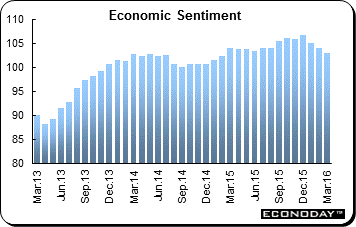 The EU Commission's March survey found economic sentiment (ESI) worsening for a third successive month. At 103.0, the headline index was down a further 0.9 points from a marginally firmer revised February reading to yield its weakest level since February 2015. The overall deterioration reflected mainly a less optimistic consumer sector where morale was confirmed at minus 9.7, a near-1 point fall from mid-quarter and its lowest level since the end of 2014. However, confidence in industry (minus 4.2 after minus 4.1), services (9.6 after 10.8) and construction (minus 20.8 after minus 17.6) also moved in the wrong direction. Only retail (1.8 after 1.4) managed a rise and even this reversed less than half of February's decline. Regionally, national ESIs fell in all four larger member states. Germany (104.0 after 104.1) saw a minimal decrease and Spain (106.9 after 107.3) held up relatively well but both France (101.9 after 103.7) and Italy (103.7 after 106.1) recorded worryingly steep declines. However, at least all remained well above the common 100 long-run average. The key inflation expectations measures painted a mixed picture. On the positive side, selling prices were seen rising in both goods industries (minus 4.6 after minus 5.6) and services (3.7 after 3.4) but inflation expectations in the consumer sector (2.1 after 3.7) dropped to a 5-month low. In addition, household buying intentions also slipped to their lowest reading since last November. The EU Commission's March survey found economic sentiment (ESI) worsening for a third successive month. At 103.0, the headline index was down a further 0.9 points from a marginally firmer revised February reading to yield its weakest level since February 2015. The overall deterioration reflected mainly a less optimistic consumer sector where morale was confirmed at minus 9.7, a near-1 point fall from mid-quarter and its lowest level since the end of 2014. However, confidence in industry (minus 4.2 after minus 4.1), services (9.6 after 10.8) and construction (minus 20.8 after minus 17.6) also moved in the wrong direction. Only retail (1.8 after 1.4) managed a rise and even this reversed less than half of February's decline. Regionally, national ESIs fell in all four larger member states. Germany (104.0 after 104.1) saw a minimal decrease and Spain (106.9 after 107.3) held up relatively well but both France (101.9 after 103.7) and Italy (103.7 after 106.1) recorded worryingly steep declines. However, at least all remained well above the common 100 long-run average. The key inflation expectations measures painted a mixed picture. On the positive side, selling prices were seen rising in both goods industries (minus 4.6 after minus 5.6) and services (3.7 after 3.4) but inflation expectations in the consumer sector (2.1 after 3.7) dropped to a 5-month low. In addition, household buying intentions also slipped to their lowest reading since last November.
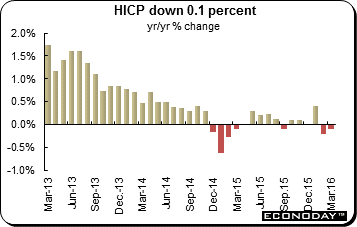 March flash harmonized index of consumer prices was down 0.1 percent on the year after declining 0.2 percent in February. There was some improvement in the underlying picture. Excluding energy, food, alcohol & tobacco the yearly rate climbed a couple of ticks to 1.0 percent to match its January mark and without just energy & unprocessed food the rate edged 0.1 percentage points firmer to 0.9 percent. Services gained 0.4 percentage points to 1.3 percent, equaling their highest outturn since last October, but this was partially offset by a decline in the non-energy industrial goods rate from 0.7 percent to 0.5 percent. Food, alcohol & tobacco weighed in at 0.7 percent, up from 0.6 percent last time, while the decline in energy steepened from 8.1 percent to 8.7 percent. March flash harmonized index of consumer prices was down 0.1 percent on the year after declining 0.2 percent in February. There was some improvement in the underlying picture. Excluding energy, food, alcohol & tobacco the yearly rate climbed a couple of ticks to 1.0 percent to match its January mark and without just energy & unprocessed food the rate edged 0.1 percentage points firmer to 0.9 percent. Services gained 0.4 percentage points to 1.3 percent, equaling their highest outturn since last October, but this was partially offset by a decline in the non-energy industrial goods rate from 0.7 percent to 0.5 percent. Food, alcohol & tobacco weighed in at 0.7 percent, up from 0.6 percent last time, while the decline in energy steepened from 8.1 percent to 8.7 percent.
 February household spending on manufactured goods was up 0.5 percent on the month following an upwardly revised 0.1 percent gain in January. Annual growth of purchases climbed from 1.9 percent to 2.6 percent, its best reading since September 2015. February's advance was driven by a 1.5 percent monthly increase in spending on food and a 1.2 percent increase in energy consumption. Autos (0.5 percent) and household durables (3.1 percent) also performed well but textiles were off 4.4 percent. Total goods spending gained 0.6 percent from January following a stronger revised 1.0 percent increase at the start of the year. As a result, average goods consumption in January/February was a healthy 1.6 percent above its fourth quarter mean. February household spending on manufactured goods was up 0.5 percent on the month following an upwardly revised 0.1 percent gain in January. Annual growth of purchases climbed from 1.9 percent to 2.6 percent, its best reading since September 2015. February's advance was driven by a 1.5 percent monthly increase in spending on food and a 1.2 percent increase in energy consumption. Autos (0.5 percent) and household durables (3.1 percent) also performed well but textiles were off 4.4 percent. Total goods spending gained 0.6 percent from January following a stronger revised 1.0 percent increase at the start of the year. As a result, average goods consumption in January/February was a healthy 1.6 percent above its fourth quarter mean.
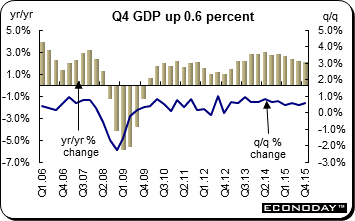 Final fourth quarter gross domestic product was revised upward to a quarterly gain of 0.6 percent from 0.5 percent. On the year, GDP was revised up to 2.1 percent from 1.9 percent. Among the major GDP expenditure components, household consumption still showed a 0.7 percent quarterly gain and continued to dominate the headline gain. However, gross fixed capital formation was revised down to a drop of 1.1 percent from previously a 0.1 percent decline and government final consumption has been trimmed from a 0.5 percent rise to 0.3 percent. The impact of these changes is offset by a larger contribution from stock building; now put at 0.4 percentage points, up 0.1 percentage point from last time. In addition, the real external accounts are not quite as negative as indicated earlier. A 0.1 percent rise in exports (previously minus 0.1 percent) and 0.9 percent increase in imports (1.2 percent) have reduced the hit on economic growth from 0.4 percentage points to 0.3 percentage points. Final fourth quarter gross domestic product was revised upward to a quarterly gain of 0.6 percent from 0.5 percent. On the year, GDP was revised up to 2.1 percent from 1.9 percent. Among the major GDP expenditure components, household consumption still showed a 0.7 percent quarterly gain and continued to dominate the headline gain. However, gross fixed capital formation was revised down to a drop of 1.1 percent from previously a 0.1 percent decline and government final consumption has been trimmed from a 0.5 percent rise to 0.3 percent. The impact of these changes is offset by a larger contribution from stock building; now put at 0.4 percentage points, up 0.1 percentage point from last time. In addition, the real external accounts are not quite as negative as indicated earlier. A 0.1 percent rise in exports (previously minus 0.1 percent) and 0.9 percent increase in imports (1.2 percent) have reduced the hit on economic growth from 0.4 percentage points to 0.3 percentage points.
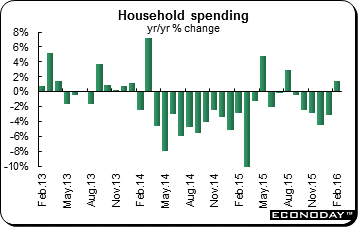 February household spending surprised and gained for the first time in six months. Spending was up 1.2 percent from a year ago in contrast to expectations of a 1.5 percent decline. Spending dropped 3.1 percent in January. Spending on education jumped 17.9 percent and medical care was 13.1 percent higher. Food was 3.3 percent higher. However, spending on housing (down 3.7 percent), fuel, light & water charges (down 3.2 percent), clothing & footwear (down 6.3 percent) and furniture & household utensils (down 4.9 percent) all were lower on the year. February household spending surprised and gained for the first time in six months. Spending was up 1.2 percent from a year ago in contrast to expectations of a 1.5 percent decline. Spending dropped 3.1 percent in January. Spending on education jumped 17.9 percent and medical care was 13.1 percent higher. Food was 3.3 percent higher. However, spending on housing (down 3.7 percent), fuel, light & water charges (down 3.2 percent), clothing & footwear (down 6.3 percent) and furniture & household utensils (down 4.9 percent) all were lower on the year.
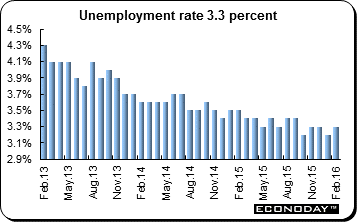 February unemployment inched up to 3.3 percent from 3.2 percent in January. Expectations were that the unemployment rate would remain 3.2 percent. Employment was up 290,000 from a year ago after jumping 900,000 in January. The labour force participation rate was 59.3, up 0.2 percent from a year ago. The job-to-applicant ratio stayed flat last month at 1.28, its highest level since December 1991. Analysts have anticipated that the high level of job availability means the unemployment rate could still decline over coming months. February unemployment inched up to 3.3 percent from 3.2 percent in January. Expectations were that the unemployment rate would remain 3.2 percent. Employment was up 290,000 from a year ago after jumping 900,000 in January. The labour force participation rate was 59.3, up 0.2 percent from a year ago. The job-to-applicant ratio stayed flat last month at 1.28, its highest level since December 1991. Analysts have anticipated that the high level of job availability means the unemployment rate could still decline over coming months.
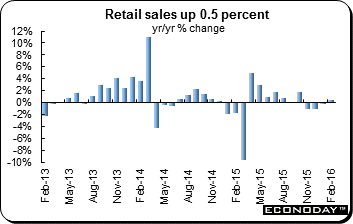 Retail sales in February increased for the first time since October. Sales were up 0.5 percent from a year ago, below expectations of a 1.5 percent gain. Sales were mixed. General merchandise sales were up 0.9 percent, fabrics, apparel & accessories were up 2.5 percent and food & beverages gained 2.7 percent. However motor vehicle sales were down 1.3 percent, machinery & equipment retreated 4.7 percent and fuel dropped 10.7 percent. Retail sales in February increased for the first time since October. Sales were up 0.5 percent from a year ago, below expectations of a 1.5 percent gain. Sales were mixed. General merchandise sales were up 0.9 percent, fabrics, apparel & accessories were up 2.5 percent and food & beverages gained 2.7 percent. However motor vehicle sales were down 1.3 percent, machinery & equipment retreated 4.7 percent and fuel dropped 10.7 percent.
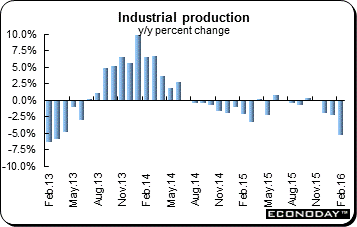 February industrial production tumbled a seasonally adjusted 6.2 percent on the month and 5.4 percent from a year ago. This was the largest drop since the 2011 tsunami when output contracted 16.5 percent. The annual change on the original index was a decline of 1.5 percent. This is in contrast to the monthly jump of 3.7 percent in January. Transport equipment tumbled 10.2 percent on the month, electronic parts & devices were down 14.7 percent and general-purpose, production & business oriented machinery slid 7.3 percent. According to the government forecast for the next two months, March output is expected to increase 3.9 percent and in April, 5.3 percent. February industrial production tumbled a seasonally adjusted 6.2 percent on the month and 5.4 percent from a year ago. This was the largest drop since the 2011 tsunami when output contracted 16.5 percent. The annual change on the original index was a decline of 1.5 percent. This is in contrast to the monthly jump of 3.7 percent in January. Transport equipment tumbled 10.2 percent on the month, electronic parts & devices were down 14.7 percent and general-purpose, production & business oriented machinery slid 7.3 percent. According to the government forecast for the next two months, March output is expected to increase 3.9 percent and in April, 5.3 percent.
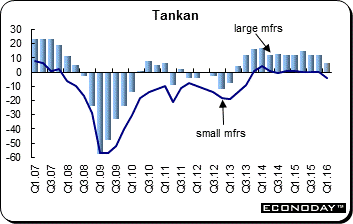 First quarter Tankan survey was weaker than expected across the board. The reading for large manufacturers was 6, down from 12 in the fourth quarter and below the consensus of 9. This was the lowest reading since a 4 in the June quarter of 2013. Small manufacturers also came in below consensus with a reading of minus 4. The large nonmanufacturing index reading eased to 22, below December's 25. Small nonmanufacturing index was 4, down slightly from December. According to the BoJ, all sectors were hit by the emerging economies' slowdown with major exporters the hardest hit. First quarter Tankan survey was weaker than expected across the board. The reading for large manufacturers was 6, down from 12 in the fourth quarter and below the consensus of 9. This was the lowest reading since a 4 in the June quarter of 2013. Small manufacturers also came in below consensus with a reading of minus 4. The large nonmanufacturing index reading eased to 22, below December's 25. Small nonmanufacturing index was 4, down slightly from December. According to the BoJ, all sectors were hit by the emerging economies' slowdown with major exporters the hardest hit.
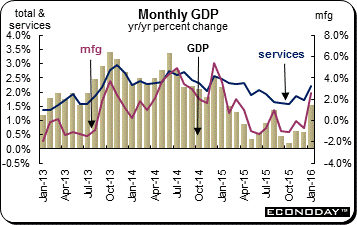 January monthly gross domestic product expanded at a 0.6 percent — the largest since July 2013 and, following an unrevised 0.2 percent rate in December, suggests that the recovery is gaining momentum. With the benefit of positive base effects, annual growth accelerated from 0.6 percent to 1.5 percent, equalling its best performance since January 2015. January's rise in total output was led by the goods producing sector which increased 1.2 percent. Within this, manufacturing was up a solid 1.9 percent and utilities an even more robust 2.7 percent. In addition, mining, quarrying & oil & gas extraction rose 0.9 percent and agriculture, forestry, fishing & hunting 0.3 percent. By comparison, a 0.4 percent advance in service sector output was relatively modest. However, there were sizeable gains in both retail trade (1.5 percent) and transportation & warehousing (1.4 percent). Finance & insurance (0.6 percent) also posted a large increase. The main offset came from arts, entertainment & recreation (down 1.2 percent) although there were also declines in management of companies & enterprises (0.3 percent), administrative & support, waste management & remediation services (0.2 percent) and other services (0.1 percent). January monthly gross domestic product expanded at a 0.6 percent — the largest since July 2013 and, following an unrevised 0.2 percent rate in December, suggests that the recovery is gaining momentum. With the benefit of positive base effects, annual growth accelerated from 0.6 percent to 1.5 percent, equalling its best performance since January 2015. January's rise in total output was led by the goods producing sector which increased 1.2 percent. Within this, manufacturing was up a solid 1.9 percent and utilities an even more robust 2.7 percent. In addition, mining, quarrying & oil & gas extraction rose 0.9 percent and agriculture, forestry, fishing & hunting 0.3 percent. By comparison, a 0.4 percent advance in service sector output was relatively modest. However, there were sizeable gains in both retail trade (1.5 percent) and transportation & warehousing (1.4 percent). Finance & insurance (0.6 percent) also posted a large increase. The main offset came from arts, entertainment & recreation (down 1.2 percent) although there were also declines in management of companies & enterprises (0.3 percent), administrative & support, waste management & remediation services (0.2 percent) and other services (0.1 percent).
Equities were mostly lower on the week but gained for the month of March. Fed Chair Janet Yellen delivered a dovish speech on Tuesday that soothed investors' worries about rising Federal Reserve interest rates. The employment report was better than anticipated. The manufacturing PMI surveys for the most part improved in March.
The Reserve Banks of Australia and India will announce their respective monetary policy decisions. The RBA is expected to leave policy unchanged while the RBI is expected to reduce its interest rate. Both the Federal Reserve and the European Central Bank publish minutes from their most recent policy meetings. Merchandise trade and industrial production data will be released in Europe along services and composite PMIs for March.
| Central Bank activities |
|
| April 5 |
Australia |
Reserve Bank of Australia Monetary Policy Announcement |
|
|
Reserve Bank of India Monetary Policy Announcement |
| April 6 |
United States |
FOMC Minutes Published |
| |
|
|
| The following indicators will be released this week... |
| Europe |
|
|
| April 4 |
Eurozone |
Producer Price Index (February) |
| April 5 |
Eurozone |
Services & Composite PMI (March) |
|
|
Retail Sales (February) |
|
Germany |
Services & Composite PMI (March) |
|
|
Manufacturers' Orders (February) |
|
France |
Services & Composite PMI (March) |
|
UK |
Services PMI (March) |
| April 6 |
Germany |
Industrial Production (February) |
| April 7 |
France |
Merchandise Trade (February) |
| April 8 |
Germany |
Merchandise Trade (February) |
|
France |
Industrial Production (February) |
|
UK |
Industrial Production (February) |
|
|
Merchandise Trade (February) |
| |
|
|
| Asia/Pacific |
|
|
| April 4 |
India |
Manufacturing PMI (March) |
| April 5 |
Japan |
Services & Composite PMI (March) |
| |
|
|
| Americas |
|
|
| April 5 |
Canada |
International Trade (February) |
| April 8 |
Canada |
Labour Force Survey (March) |
Anne D Picker is the author of International Economic Indicators and Central Banks.
|

